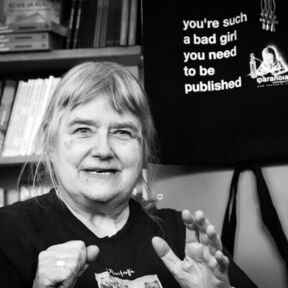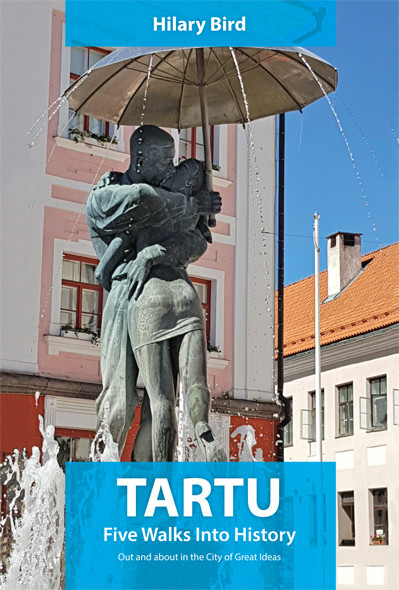TARTU · Five Walks Into History
The Estonian university town Tartu is packed with charm and history. Imagine yourself walking along its streets, accompanied by a tour guide knowledegeable about every nook and cranny of this lively jewel in southern Estonia. Moreover, this brilliant guide has selected only the most interesting attractions of the city to tell you about, peppered with historical details and intriguing stories, and has packaged them all neatly into five easy to follow walks, each including a map.
The author, Hilary Bird hopes you enjoy exploring Tartu at least half as much as she has loved uncovering the historical tidbits of her home town and compiling them into this tourist guide.
TARTU · Five Walks Into History · By Hilary Bird
A tourist guide with delightful glimpses into the history of Tartu, a univeristy town in southern Estonia, set up as five easy-to-follow walks of reasonable length, each having its own theme. Includes maps of the walks. 270 pages, an index, filled with color photographs.
View sample pages from the book
Explore Tartu through five walks:
| Walk 1: The Old Town Town Hall Square · Rüütli, Munga and Magasini Streets · Medieval Tartu · The Botanical Gardens and Lai St · Jaani and Lutsu Streets · The University (Ülikooli St) · Polish Tartu (Jakobi St) |
 Explore the buildings and sights in Town Hall Square, including the Town Hall, the Kissing Students fountain, the leaning house, find out the connection between the Arch Bridge and Catherine The Great, get to know the significance of the statues along the river bank, pass by or through the Botanical Gardens, acquaint yourself with the museums, churches, hotels, and historical buildings of Lai and Rüütli Streets, learn about the history of education in Tartu, make a stop at the University of Tartu, St. John's Church (Jaani kirik), and the many sights of significance on Jakobi Street. |
| Walk 2: Toomemägi (Cathedral Hill) The Cathedral · The Sacrificial Stone, the Kissing Hill (Musumägi) and the Grotto · Kassitoome (Cat Valley) · Tarbatu and the Observatory · The public parks |
 This walk explores the area around the earliest sites of settlement in Tartu. You'll see the site of Tarbatu, the ancient Estonian hill fort, and the Cathedral, as much a fortress as a church. On a gentler note, the attractions include the Observatory, where thousands of stars were discovered, and the 19th century hospital where, until recently, most people of the town first saw the light of day. And it was here that the Estonians took their first steps towards modern nationhood when, in 1869, the singers of the first All-Estonian Song Festival stepped out from Toomemägi. The name Toomemägi derives from the German "Domberg", meaning literally "Cathedral Hill". It can be reached by climbing the steep path that starts at Jakobi St 4 behind the main building of the university. A slightly less steep way to ascend the hill is via Pirogov Square, along Lossi St. |
| Walk 3: Over the Emajõgi River Around Ülejõe Park · Jaama St · Raadi Manor · Old Soviet air field · The Estonian National Museum · Upside down house · Tartu City Museum |
 Walk 3 is particularly suitable for those who like museums. There are two important museums - the local Tartu City Museum and the Estonian National Museum - on this route. The museums are quite a distance apart, so the walk has been split into two for those who do not want to walk too far. See fragments of Venetian glass, see an upside down house and get a glimpse of Soviet military power. This area is also important for the religious life of Tartu. A Moravian Prayer House once stood here, and the walk will take you to important Orthodox and Lutheran churches. If you are interested in the more sinister side of history, you can see the site of town gallows. It is now a harmless potato patch. |
| Walk 4: Commercial Tartu, the Historical and Modern The site of the historical Tartu Market · Modern Market Hall · Market Bridge · Emajõe Business Centre · AHHAA Centre · Kaubamaja · Kvartal |
 The banks of the Emajõgi River were, for centuries, a place of buying, selling, and handling of goods in transit. There is archaelogical evidence that a settlement existed here from around 400 AD. Other finds, including a large hoard of Arabian coins, associated with Viking traders, indicate that, by 1000 AD, Tartu was a thriving centre with a fort, a harbour, and a market area with rised pavements like those of Novgorod that was founded by Vikings in 930 AD. This walk will take you through the historical and current commercial district of Tartu, and is a great option for shoppers. |
| Walk 5: Vanemuise Street -- the "Street of Culture" Riga Hill (Riia)· The Vanemuine theatres - Grand and Little· The Natural History Museum · The old moat (Vallikraavi) · Barclay Square |
 This is a walk for people interested in the history of both Tartu and Estonia. The route takes in several museums, theatres, libraries, and historical sites. Starting at Riia Hill, it tells the story of Pallas School of Art, passes by the courthouse and the Baltic Defence College before turning onto Vanemuise St where the Estonian Literary Museum, The Natural History MuseumIt and the Little Vanemuine Theatre are located. It passes by the building where the Tartu Peace Treaty with Soviet Russia was signed in 1920, ending Estonia's War of Independence. It also enables you to take a quick pivot into a green where a favorite oak tree of the famed Estonian poetess, Lydia Koidula, still stands where there used to be the yard of her childhood. The walk then passes by, and tells the story of the Estonian Writers' Union, but also touches on the darker side of history at the KGB Cells Museum and the Cornflower memorial for the victims of Stalinism. Naturally, it tells about the Vanemuine Theatre and concert hall, touches on the Tartu University Library and University of Tartu History Museum before heading down the Senff steps towards the old moat. There it touches on historical sites connected to the Estonian War of Freedom hero Julius Kuperjanov and the writer Eduard Vilde. It then meanders through Barclay Square, explaining the significance of Barclay de Tolly, a general in the Napoleonic wars, and his connection to Tartu. |
| Plus, a bonus chapter on cemeteries and archives - useful for those who might be looking for their roots just like the author herself has done. |
"It's an unbelievably thorough book of the highlights of Tartu. Even locals can learn an interesting fact or two about their home town."
Urmas Klaas, the Mayor of Tartu
The book will be shipped from Tallinn, Estonia. The e-store is run by Lakeshore Press Estonia OÜ.

ESTONIA, Omniva - €3.84;
FINLAND, Smartpost - €10.00; up to 5 books
EU, Postal service - €16.99; up to 5 books
US & CANADA, Postal service - €19.99; up to 5 books
WORLD, Postal service - €29.99; up to 5 books
Since the international delivery costs offered by postal services are quite high, it pays to pool orders with friends.
The book is also available at Apollo and Rahva raamat stores in Estonia, as well as the Krisostomus store in Tartu, and the Tartu Tourist Information Centre in Town Hall Square.
About Hilary

Hilary Bird,
writer
Hilary Bird was born Anneliise Meikar in the UK in 1948. She was adopted by Em and Harry Bird and lived in the UK until she retired. Hilary/Anneliise found her Estonian family in Lääne Virumaa in 1998. In 2002 she came to Tartu to study at the University and never went back to the UK. She still lives, with her cat Jelli, in Tartu where she is a PhD candidate and writes books.
Published works by Hilary
Hilary Bird is a writer. Her 400-page English language “Introduction To Estonian Literature” was published by Slavica Publishers, Indiana University, USA, in 2018. She is the main author of “Xenophobe's Guide To The Estonians” (UK, 2010) and has written travelogues about the Baltic region for the National Geographic “500 Journeys of a Lifetime.” As a journalist, Hilary has written about Estonian culture and history for the Esto-Canadian press ("Eesti Elu" and "Estonian World Review") and, in Estonia, for "Maaleht" (“The Country Paper” ) with the late translator, Mati Soomre. She is currently planning publication of a collection of poetry by Estonian women called “The Poetry of Survival.”
Her most recently published work, ten years in the coming, is about her current home town, Tartu in Estonia, and is titled "TARTU. Five Walks Into History." It is a tourist guide outlining the see-worthy places and buildings in Tartu while revealing delightful historical tidbits about each of them.

